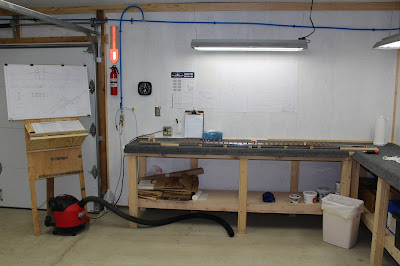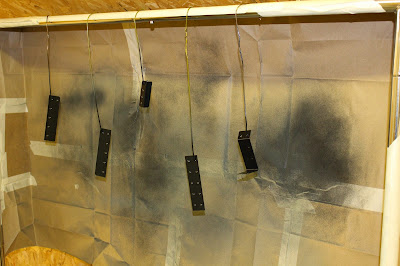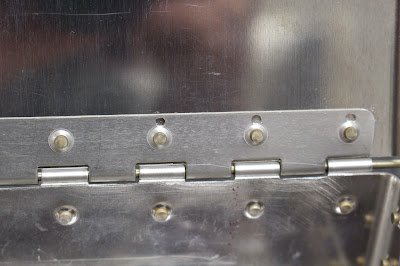I like the title of this post. Like plans and instructions, it can be interpreted in so many ways...
Actual work on the empennage began on May 19, when I removed the vinyl all the covered alclad parts except the outside of the skins. Whether or not to remove the vinyl is only one of the many aspects of building a Vans aircraft that is subject to debate among builders. I based my decision to remove the vinyl on several factors. First, Vans recommends removing the vinyl as soon as practical, because the vinyl glue can become more difficult to remove as it gets older, and it can also trap moisture that can start corrosion. Since I will be painting my aircraft flat olive drab and neutral grey and want to replicate the rough-and-ready look of a mid-war fighter that is being rushed off a production line, I'm not worried about tiny scratches on the skins or other alclad parts. I keep my carpeted work surfaces as clean as possible, and wear gloves while handling parts to minimize fingerprints and smudges. I'm leaving the exterior skin vinyl on to protect it while the skins are nested in storage and handled during match drilling, and removing it just before deburring and dimpling.
Perhaps the biggest subject of debate has been priming and painting... even to the point that Vans has a running gag on their phone system about it. While waiting on hold for builder support, I heard one of the automated voices say "We apologize for the delay; Vans is currently working on negotiating a truce in the primer wars", which made me laugh. After giving this a lot of thought and research, including reading all of Vans recommendations and discussing it with their builder support and other RV builders, I've decided that I will only prime non-alcad interior parts. Exterior parts will receive the proper primer and topcoat. Given the expected use this aircraft will see, and the fact that I intend to always keep it hangared in a non-salt-air environment, I do not expect to have any corrosion problems during my lifetime.
I started work on the horizontal stabilizer rear spar assembly, and completed most of the initial work in one day. I discovered that I was missing two elevator hinge brackets, so I ordered them from Vans. This should have been a no-cost item, but I paid extra shipping to expedite delivery as this was discovered right before the long Memorial Day weekend.
I painted the aluminum flange of the center bearing before assembling the bearing bracket. I applied metal-etching primer and a top coat of flat camo green.
This was the very first rivet I drove on my aircraft... a momentous occasion.
The plans call for using AN470AD4-5 length rivets on this assembly. My first couple rivets seemed fine, but the shop head was very slightly undersized in diameter. It was obvious that I'd have to overdrive the rivets to get them to fit the rivet gauge, and I didn't want to do that. Later, I checked other builders websites, and learned that some builders used -6 rivets in this location. I made a note to check with Vans about this later. I drove all six rivets with the assembly clecoed to the rear spar; it seemed a better idea than trying to clamp it elsewhere. I laid down towels to protect the spar from nicks from the gun or bucking bar. There was one rivet I wasn't happy with; overdriven with a significant smilie on the manufactured head, so I drilled it out and drove another which looked much better.
My next step was making templates for bending the 6 degree angle into the reinforcement angle, splice angle and front spar tabs; the spar doublers are manufactured with this bend in place. I made one out of heavy paper stock, and another out of scrap aluminum.
I drilled the first batch of holes in the front spar tabs, doublers and angles. I laid out and cut the tapers on the ends of the angles in stages using a hacksaw, grinding wheel, vixen file and scotchbrite wheel to sculpt the final shape.
I got the 6 degree bends dialed in on the angle pieces, but held off bending the front spar tabs because I suspected some clearance problems. If I had drilled and cut the relief holes on the spar tabs as they were shown on the blueprints, they would have come much too close to some of the rivet holes. At this point, I figured I had enough questions to warrant my first call to Vans Builder Support. I asked about the rivet size for the center bearing bracket assembly, and they said the rivets I set should be fine. The adviser put my mind at ease with his relaxed attitude, reminding me that this wasn't microsurgery; I'm building airplane parts. Measurements need not be made down to the thousandths (at least not in this instance); reasonable tolerances are to be expected. That was good news to me, because I could sense that I may have been heading down the road to OCD with this project, and it would be unrealistic to expect perfection with the skill set I have now. This is an educational project; it is under that premise that experimental aircraft are even allowed to exist. I asked about the front spar tab relief notch, and how the blueprint design would impinge on the nearest rivet hole. Again, he said the notch didn't need to look exactly like the blueprint, and in any case it probably shouldn't be any deeper than the relief milled into the spar doubler, which is much shallower than the blueprint notch. Creating the notch with a circular file and smoothing the corners and edges would be just fine. Same with trimming the front spar flanges to clear the inboard rib; the blueprints didn't specify the angle of the trim, or any specific measurements. The advisor said just make sure it clears, and isn't too close to the nearest flange/skin rivet hole... more on that later.
My last question was about the aircraft serial number. I had tried to determine what mine would be, and even after doing research through the VAF site and others, I hadn't drawn any firm conclusions. I was told that, as the builder of the aircraft, I could assign any aircraft serial number I wanted to use, but it was common practice for most Vans aircraft builder to use their builder's number as they are specific to each individual aircraft, rather than the person doing the building. I also learned that the first one or two numbers designate the model of Vans RV aircraft (3, 4, 6, 7, 8, 9, 10, 12, 14) and the following numbers are the builder number of that model. So in my case, 83507 indicates that I am builder #3507 of the RV-8 model. Works for me; that will be my serial number.
I also went to the FAA's website and reserved my tail number. My goal was to create an N number that held significance to me, but more importantly it had to be something easy to read back on the radio; something that would roll off my clumsy tongue. I wrote down some possibilities, and found a few available numbers that would fit the bill, so I reserved one. And of course now that I had that piece of the puzzle, I went back into all my previous RV-8 artwork featuring my current paint scheme, and added the correct N-number to each drawing. I also designed VAF and RV-8 logos that I will use on custom T-shirts, polo shirts, coveralls and flight suits. Now that I'm officially in the club, I want to look the part.
This logo is for T-shirts and the back of coveralls and flight suits:
This logo is for the name badge on coveralls and flight suits:

This logo is for the name badge on coveralls and flight suits:

This is the polo shirt logo:
Back to building. I notched the front spar tabs and bent them to the required angle. Now the spars, doublers and angles all fit together properly. As for the spar flange trimming, the blueprint drawing showed an angle that worked out to be about 19 degrees. I chose an even 20 degrees as a starting poing, cut them with shears and smoothed the edges. As building progressed, I realized they needed additioal relief to clear the front flanges of the inboard ribs, but I wouldn't know how much until I did a test-fit with the skins on. I didn't know it then, but I was making things rather difficult for myself with this plan. Meanwhile, the missing hinge brackets arrived, so I match-drilled them. I fluted and deburred the ribs for both sides, and assembled the left skeleton to test-fit the skin.
Getting the skin in place was a little more awkward than expected, and created some scratches on the inside of the skin around the front of the ribs. But I adjusted my personal "be careful, you clumsy idiot" setting to a higher level, and soon it was clecoed nicely in place. Test fitting the left inboard rib confirmed that more relief was needed on the front spar flanges... so that meant removing most of the skin clecos and carefully pulling the front spar away from the skin and ribs. Some work with a dremel tool and the scotchbrite wheel on both the front spars and the front rib flange notches, and I had the clearance I needed... and now I also knew where the inboard rib needed to fit on the front spar, so I could do the work on the right spar before I test-fit that skin.
The instructions say to do all the test-fitting on the left horizontal stabilizer and duplicate the process on the right one, but I ended up doing both somewhat concurrently. As a result, I had to be careful not to miss a step... but I was working slowly and methodically, double-checking myself often, so nothing was forgotten. Some of the spar holes can't be drilled until this stage, and some of the access is tight. The Cleaveland Tools RV builder's toolkit didn't include an angle drill, and it looked like I might need one at this stage. Harbor Freight didn't have one that was small enough, so I ordered an angle drill adaptor kit from Cleaveland Tool, along with a footed bucking bar. As I continued working, I realized I could access the difficult spar holes using the long flexible bits that come with the original toolkit, so I used those to drill the initial holes to #40. Once the inboard rib fitting was complete, I match-drilled all the skin holes to the ribs and spars on both sides.
I removed the skins, assembled both skeletons and finished a few remaining spar holes. The plans never mentioned having to drill the difficult spar holes out to #30, but I knew it was necessary based on the rivet call-out. Nevertheless, I called and checked with Vans before resizing them, because it's easy to make a hole larger, but very difficult to make one smaller. I wanted to make sure I was doing it right. That was when I discussed the Primer Wars with the advisor, and made the decision to only prime the non-alclad parts with a light coat of metal-etching primer. With all the drilling done, I disassembled everything in preparation for deburring and dimpling, which I will start tomorrow... June 1... after I pay the monthly bills, of course.
So ends the eventful month of May. I keep reminding myself that I have the luxury of time on my side. Since I won't be able to order the wings and fuselage quickbuild kits for at least seven months to a year, I can move as slowly and carefully as I wish on this part of the project, which reduces the risk of making making the kind of mistakes that can happen from doing something before I'm ready. I still have the SportAir Workshop and all of AirVenture to come... and that trip is getting closer. The details of my itinerary are coming together and will include the VAF gathering Monday night, which should be especially fun. I'm working on getting the custom shirts and overalls made, and will post photos when they are done. Now that I have serial and registration numbers, I will pursue builder's insurance... and that may allow me to start a hangar lease at PTK. Speaking of which, I am flying twice a month now with the instructors at DCT Aviation, in Warriors and Archers when the weather is good, and in simulators when it isn't. The weight loss still continues; I'm down almost 40 pounds so far. That's almost halfway to my goal weight, which is very encouraging. As for this blog, I'm beginning to think I may make monthly entries here, since I've been doing the KitLog Pro entries daily. I will play that by ear; after all, I'm used to that. I've been playing songs by ear for fifty years now. Hope I can say that about flying someday.. or at least come close.








































































